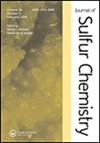DFT study of the adsorption of simple organic sulfur gases on g-C3N4; periodic and non-periodic approaches
IF 2.1
3区 化学
Q3 CHEMISTRY, MULTIDISCIPLINARY
引用次数: 0
Abstract
In the present work, the adsorption of some simple organic sulfur gases (CS2, OCS, and CH3SH) on the g-C3N4 was studied using periodic and non-periodic density functional theory (DFT). PBE-D3/DNP and B3LYP-D3/6-31G(d) levels of theory were employed for periodic and non-periodic calculations, respectively. The calculated CS2, OCS, and CH3SH adsorption energies were obtained to be −4.35, −5.82, and −8.58 Kcal/mol. The interactions of simple organic sulfur gases with g-C3N4 were characterized by NBO second-order perturbation theory and quantum theory of atom in molecule (QTAIM). The bandgap energies and work function of g-C3N4 and its complexes with simple organic sulfur gases were extracted from their band structures. The CS2 and OCS adsorptions didn’t significantly alter the bandgap and work function of g-C3N4. Therefore, g-C3N4 is not a proper sensor for detecting CS2 and OCS. The bandgap and work function of g-C3N4 were averagely changed by 18% and 2.7%, respectively, after CH3SH adsorption. Accordingly, g-C3N4 may use as a suitable sensor for detecting CH3SH based on electronic conductivity and work function.
g-C3N4吸附简单有机硫气体的DFT研究周期和非周期方法
本文采用周期和非周期密度泛函理论(DFT)研究了g-C3N4对几种简单有机硫气体(CS2、OCS和CH3SH)的吸附。PBE-D3/DNP和B3LYP-D3/6-31G(d)理论水平分别用于周期和非周期计算。计算得到CS2、OCS和CH3SH的吸附能分别为- 4.35、- 5.82和- 8.58 Kcal/mol。用NBO二阶微扰理论和分子原子量子理论(QTAIM)表征了简单有机硫气体与g-C3N4的相互作用。从g-C3N4及其与简单有机硫气体配合物的能带结构中提取了带隙能和功函数。CS2和OCS的吸附对g-C3N4的带隙和功函数没有显著影响。因此,g-C3N4不是检测CS2和OCS的合适传感器。吸附CH3SH后,g-C3N4的带隙和功函数平均变化分别为18%和2.7%。因此,基于电子电导率和功函数,g-C3N4可以作为检测CH3SH的合适传感器。
本文章由计算机程序翻译,如有差异,请以英文原文为准。
求助全文
约1分钟内获得全文
求助全文
来源期刊

Journal of Sulfur Chemistry
CHEMISTRY, MULTIDISCIPLINARY-
CiteScore
4.10
自引率
9.10%
发文量
38
审稿时长
6-12 weeks
期刊介绍:
The Journal of Sulfur Chemistry is an international journal for the dissemination of scientific results in the rapidly expanding realm of sulfur chemistry. The journal publishes high quality reviews, full papers and communications in the following areas: organic and inorganic chemistry, industrial chemistry, materials and polymer chemistry, biological chemistry and interdisciplinary studies directly related to sulfur science.
Papers outlining theoretical, physical, mechanistic or synthetic studies pertaining to sulfur chemistry are welcome. Hence the target audience is made up of academic and industrial chemists with peripheral or focused interests in sulfur chemistry. Manuscripts that truly define the aims of the journal include, but are not limited to, those that offer: a) innovative use of sulfur reagents; b) new synthetic approaches to sulfur-containing biomolecules, materials or organic and organometallic compounds; c) theoretical and physical studies that facilitate the understanding of sulfur structure, bonding or reactivity; d) catalytic, selective, synthetically useful or noteworthy transformations of sulfur containing molecules; e) industrial applications of sulfur chemistry; f) unique sulfur atom or molecule involvement in interfacial phenomena; g) descriptions of solid phase or combinatorial methods involving sulfur containing substrates. Submissions pertaining to related atoms such as selenium and tellurium are also welcome. Articles offering routine heterocycle formation through established reactions of sulfur containing substrates are outside the scope of the journal.
 求助内容:
求助内容: 应助结果提醒方式:
应助结果提醒方式:


